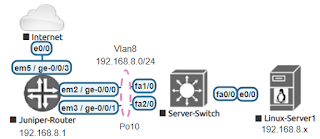Objective: To configure port-channel and associate it to vlan.
Servers will use Juniper-Router as their gateway and uplink to Internet. Server-switch have Layer 2 (access mode) connectivity to Juniper-Router. (see Fig.1)
Fig.1
1. Configure the Vlan (interface vlan will be the server’s gateway)
Juniper-Router#
configure
set vlans VLAN-8 description Server-Farm
set vlans VLAN-8 vlan-id 8
set vlans VLAN-8 l3-interface irb.8
set interfaces irb unit 8 description “Server Farm Vlan”set interfaces irb unit 8 family inet address 192.168.8.1/24
2. Configure port-channel
set interfaces ae10 description “Port-channel to Server-Switch”set interfaces ae10 aggregated-ether-options link-speed 1gset interfaces ae10 aggregated-ether-options lacp activeset interfaces ae10 unit 0 family ethernet-switching interface-mode accessset interfaces ae10 unit 0 family ethernet-switching vlan members VLAN-8
3. Configure physical members
set interfaces ge-0/0/0 description “Connection to Server-Switch fa1/0”set interfaces ge-0/0/0 gigether-options 802.3ad ae10
set interfaces ge-0/0/1 description “Connection to Server-Switch fa2/0”set interfaces ge-0/0/1 gigether-options 802.3ad ae10
4. Commit all changes
commit
Verification and sample output:
Server1 = 192.168.8.20
Server2 = 192.16 8.8.21
show arp interface <interface id>
ARP:
Juniper-Router> show arp interface ae10.0
MAC Address Address Name Interface Flags
00:11:ab:cd:ef:00 192.168.8.20 192.168.8.20 ae10.0 none
00:11:ab:cd:ef:01 192.168.8.21 192.168.8.21 ae10.0 none
Total entries: 2
{master}
Ping:
ping <IP> source <interface IP> count <values>
user1@Juniper-Router-re0> ping 192.168.8.20 source 192.168.8.1 count 2
PING 192.168.8.20 (192.168.8.20 ): 56 data bytes
64 bytes from 192.168.8.20 : icmp_seq=0 ttl=64 time=1.162 ms
64 bytes from 192.168.8.20 : icmp_seq=1 ttl=64 time=1.098 ms
— 192.168.8.20 ping statistics —
2 packets transmitted, 2 packets received, 0% packet loss
round-trip min/avg/max/stddev = 1.098/1.130/1.162/0.032 ms
{master}
Check Port-channel:
show lacp interfaces <interface id>
user1@Juniper-Router-re0> show lacp interfaces ae10
Aggregated interface: ae10
LACP state: Role Exp Def Dist Col Syn Aggr Timeout Activity
ge-0/0/0 Actor No No Yes Yes Yes Yes Slow Active
ge-0/0/0 Partner No No Yes Yes Yes Yes Slow Active
ge-0/0/1 Actor No No Yes Yes Yes Yes Slow Active
ge-0/0/1 Partner No No Yes Yes Yes Yes Slow Active
Check Vlan:
show vlans <vlan name>
user1@Juniper-Router-re0> show vlans VLAN-8
Routing instance VLAN name Tag Interfaces
default-switch VLAN-100 100
Verify the traffic:
monitor interface ae10.0
monitor interface ge-0/0/0
monitor interface ge-0/0/1
For VLAN configuration in Cisco, pls. refer to this link –> –> Configuring Port-Channel and VLAN in Cisco Nexus

[…] Objective: To configure port-channel and associate it to vlan. Servers will use Cisco-NXOS as their gateway and uplink to Internet. Server-switch have Layer 2 (access mode) connectivity to Cisco-NXOS router. (see Fig.1) Fig.1 1. Configure the Vlan (interface vlan will be the server’s gateway) Cisco-NXOS# configure vlan 8 name Server-Farm interface Vlan8 description Server Farm Vlan no shutdown ip address 192.168.8.1/24 2. Configure port-channel interface port-channel10 description Port-channel to Server-Switch switchport access vlan 8 3. Configure physical members interface eth1/1 description Connection to Server-Switch fa0/1 switchport access vlan 8 channel-group 10 mode active no shutdown interface eth1/2 description Connection to Server-Switch fa2/0 switchport access vlan 8 channel-group 10 mode active no shutdown Verification and sample output: Server1 = 192.168.8.20 Server2 = 192.16 8.8.21 ARP: Cisco-NXOS# show ip arp vlan8 Flags: * – Adjacencies learnt on non-active FHRP router + – Adjacencies synced via CFSoE # – Adjacencies Throttled for Glean CP – Added via L2RIB, Control plane Adjacencies PS – Added via L2RIB, Peer Sync RO – Re-Originated Peer Sync Entry D – Static Adjacencies attached to down interface IP ARP Table Total number of entries: 2 Address Age MAC Address Interface Flags 192.168.8.20 00:15:47 0011.abcd.ef00 Vlan8 192.168.8.21 00:15:47 0011.abcd.ef01 Vlan8 Ping: Cisco-NXOS# ping 192.168.8.20 source 192.168.8.1 PING 192.168.8.20 (192.168.8.20) from 192.168.8.1: 56 data bytes 64 bytes from 192.168.8.20: icmp_seq=0 ttl=63 time=0.62 ms 64 bytes from 192.168.8.20: icmp_seq=1 ttl=63 time=0.441 ms 64 bytes from 192.168.8.20: icmp_seq=2 ttl=63 time=0.454 ms 64 bytes from 192.168.8.20: icmp_seq=3 ttl=63 time=0.54 ms 64 bytes from 192.168.8.20: icmp_seq=4 ttl=63 time=0.394 ms — 192.168.8.20 ping statistics — 5 packets transmitted, 5 packets received, 0.00% packet loss round-trip min/avg/max = 0.394/0.489/0.62 ms Check Port-channel: Cisco-NXOS# show int port-channel 10 | i Members Members in this channel: Eth1/1, Eth1/2 Check Vlan: Cisco-NXOS# show vlan 8 Server-Farm active Po10 Verify the traffic: show int port-channel1 show int vlan8 show int eth1/1 show int eth1/2 Here’s the Juniper version for this –> Configuring Port-Channel and VLAN in Juniper […]